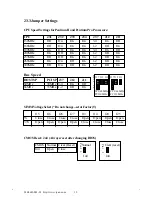
25
S1686D-001-01
Chapter 4: Troubleshooting
4.1 Troubleshooting Procedures
Use the following procedures to troubleshoot your system. If you have followed
all of the procedures below and still need assistance, refer to the "Technical
Support Procedures" and/or "Returning Merchandise for Service" section(s) in
this chapter.
No-Video
If you do not have video, follow the Troubleshooting Flowchart on the next
page.
1. Check for missing jumpers or improper installation of the ROM BIOS.
2. Make sure the video card and its jumper setting (as appropriate) match the
monitor type.
3. Check to make sure that all peripheral cards are properly installed in their
slots.
4. Check for incorrect cache memory jumper settings that may prevent accurate
detection of memory.
5. The I/O Bus speed should be running at the standard speed of 8 MHz.
6. Use the speaker to determine if any beep codes exist. Refer to Addendum A
and Addendum B for details about beep codes.
Note: If you are a system integrator, VAR, or OEM, a POST diagnostics card is
recommended for Port 80h codes. (Please visit our Web Site for detailed
information.)
Memory Error/Parity Error
If you encounter memory or parity errors, follow the procedures below.
1. Check to determine if SIMM modules are improperly installed.
2. Make sure that different types of SIMMs have not been installed in the
same bank. (eg. a mixture of 265KB x 9 and 1 MB x 9)















































